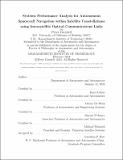| dc.contributor.advisor | Cahoy, Kerri | |
| dc.contributor.advisor | De Weck, Olivier | |
| dc.contributor.advisor | D’Amico, Simone | |
| dc.contributor.advisor | Paluszek, Michael | |
| dc.contributor.author | Grenfell, Peter | |
| dc.date.accessioned | 2024-03-15T19:23:22Z | |
| dc.date.available | 2024-03-15T19:23:22Z | |
| dc.date.issued | 2024-02 | |
| dc.date.submitted | 2024-02-16T20:56:01.312Z | |
| dc.identifier.uri | https://hdl.handle.net/1721.1/153778 | |
| dc.description.abstract | Free-space optical communications is an advanced technology for high data rate communications that has experienced rapid development for space applications over the last couple decades, due to the increasing need for bandwidth with modern sensing and information technologies. Lasercom has advantages over radio frequency (RF) systems, with the primary advantage being better scalability of terminal data rates versus Size, Weight, and Power (SWaP) constraints. A lasercom terminal already has the necessary hardware for optical intersatellite link (OISL) measurements, since it is the same hardware that is needed for communications. Intersatellite measurements can be used to improve the observability of satellite orbits in applications like satellite communications constellations. We will perform a systems analysis of the OISL measurement technology to better understand how measurement errors are related to the hardware design. We analyze relativistic effects when modeling the intersatellite light propagation. We expand on previous constellation analyses, in particular navigation via OISLs within LEO mega-constellations like Starlink, Earth navigation constellations like the Global Positioning System (GPS), and notional Lunar & Mars constellations. We estimate the achievable performance in these applications and show that baseline OISL navigation performance is on the order of 0.1-10 m and 0.1-10 mm/s, depending on the application configuration. This is comparable to existing state-of-the-art non-autonomous navigation methods like GPS and radio ground tracking and at least one order of magnitude better than existing autonomous navigation methods such as optical navigation. Lasercom crosslinks not only enable increased throughput in satellite communications constellations, but they can also be used to enable collectively-autonomous, high-precision navigation. | |
| dc.publisher | Massachusetts Institute of Technology | |
| dc.rights | In Copyright - Educational Use Permitted | |
| dc.rights | Copyright retained by author(s) | |
| dc.rights.uri | https://rightsstatements.org/page/InC-EDU/1.0/ | |
| dc.title | Systems Performance Analysis for Autonomous Spacecraft Navigation within Satellite Constellations using Intersatellite Optical Communications Links | |
| dc.type | Thesis | |
| dc.description.degree | Ph.D. | |
| dc.contributor.department | Massachusetts Institute of Technology. Department of Aeronautics and Astronautics | |
| mit.thesis.degree | Doctoral | |
| thesis.degree.name | Doctor of Philosophy | |
